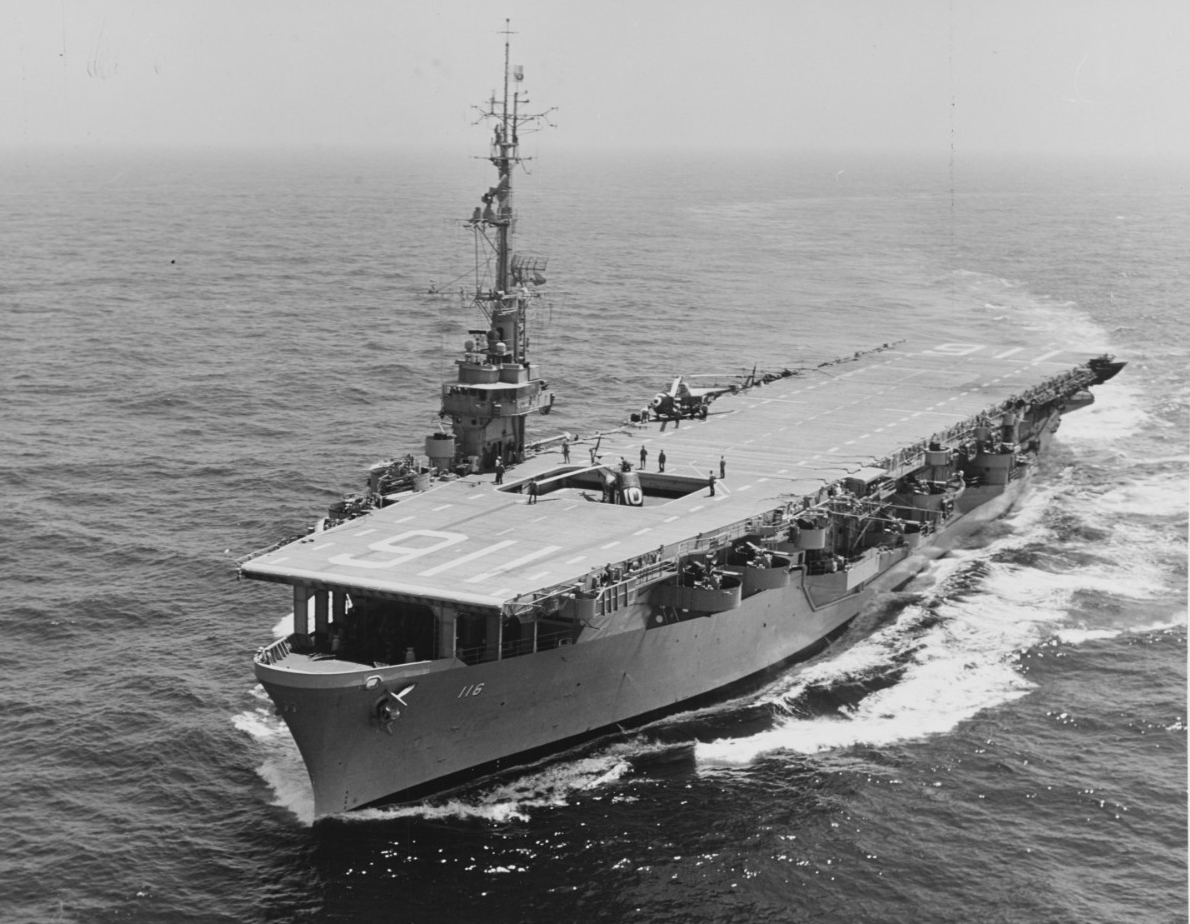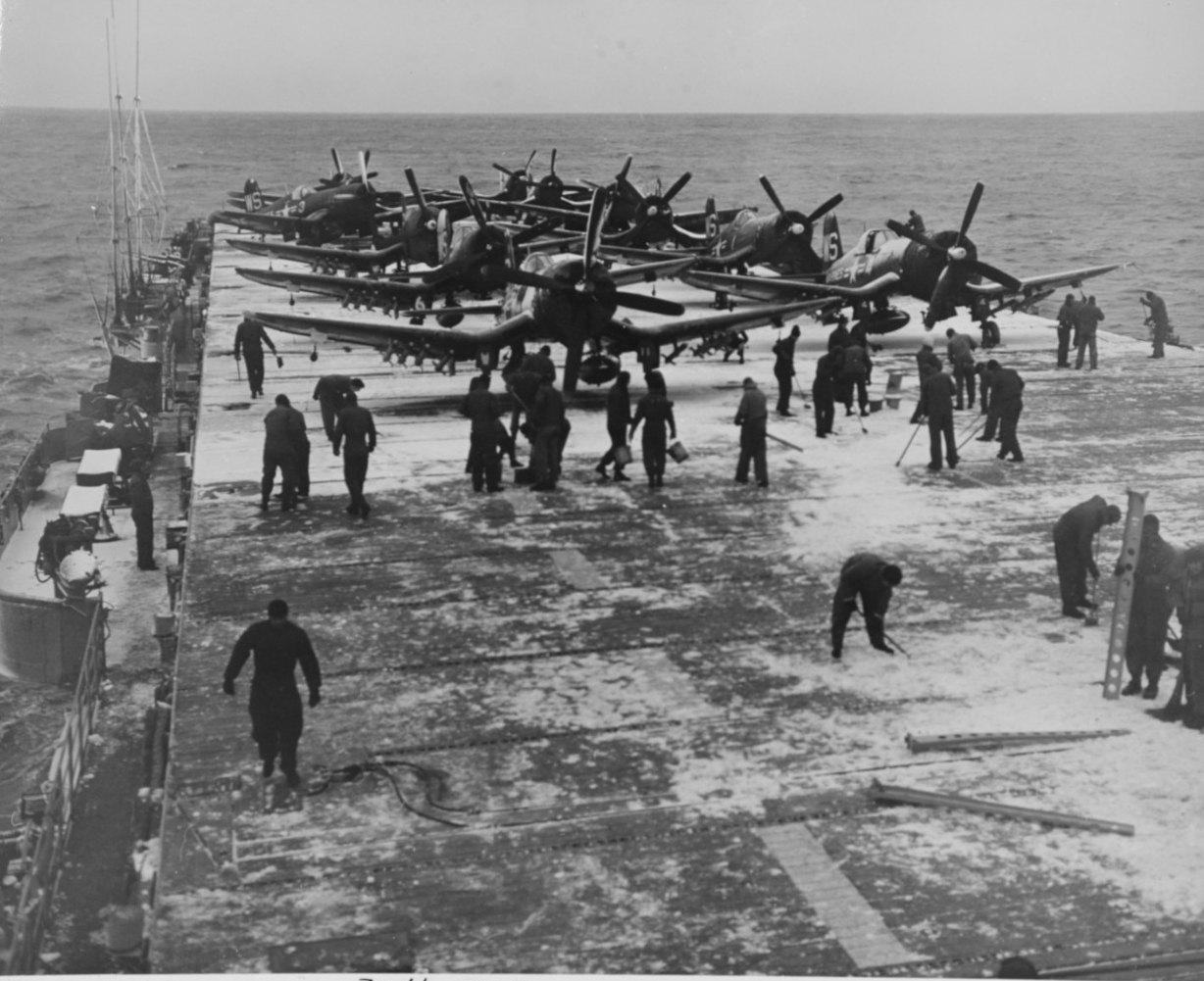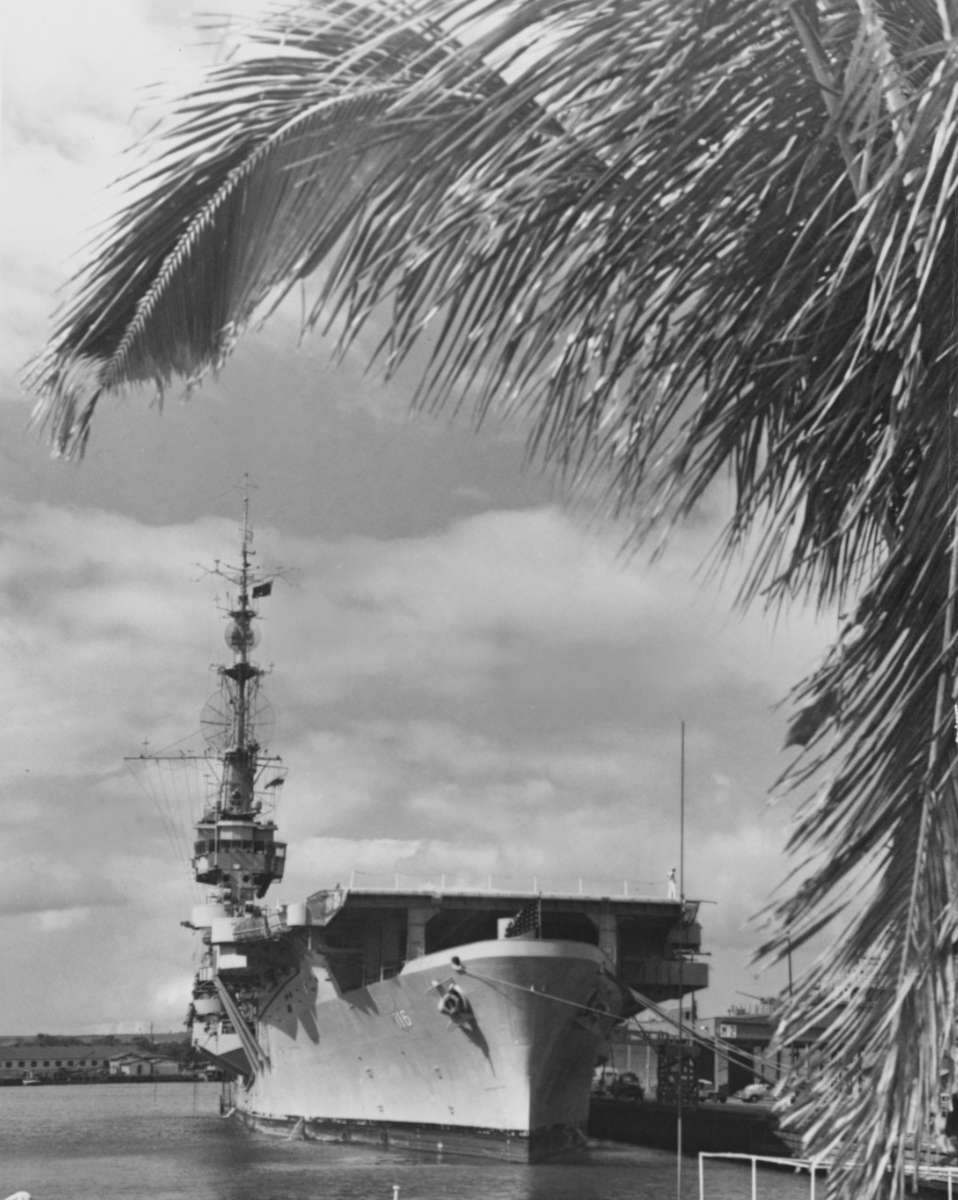Badoeng Strait (CVE-116)
1945–1970
Other resources: Korean Combat Action Reports for Badoeng Strait (CVE 116)
A strait in the Netherlands East Indies (now Indonesia), between the islands of Bali and Nusa Besar and at the confluence of the Bali Sea and the Indian Ocean. It was the site of a night surface action between Japanese naval units and a Dutch-American force early in the Pacific War. Japanese naval forces, having seized Borneo and the Celebes in January 1942, sailed to Bali in mid-February. Allied ships departed Tjilatjap and Ratai Bay, Sumatra, to intercept the Japanese. The Allied force (Rear Adm. Karel W.F.M. Doorman, RNN) of three cruisers and accompanying destroyers attacks the retiring Japanese Bali occupation force (Rear Adm. Kubo Kyuji) in Badoeng Strait on the evening of 19 February. Destroyer Stewart (DD-224) is damaged by gunfire of destroyers Oshio and Asashio. Dutch destroyer Piet Hien is sunk and Dutch light cruisers Java and Tromp are damaged by Japanese gunfire. Japanese destroyers Ushio and Michisio are damaged by Allied gunfire. The naval engagement did not prevent the loss of Bali, or the Dutch East Indies.
(CVE-116: displacement 24,275; length 557'1"; beam 75'0"; extreme width 105'2"; draft 30'8"; speed 19.1 knots; complement 1,066; armament 2 5-inch, 36 40-millimeter, 20 20-millimeter; aircraft 34; class Commencement Bay)
Badoeng Strait (CVE-116) was laid down on 18 August 1944 at Tacoma, Wash., by the Todd-Pacific Shipyards, Inc.; launched on 15 February 1945; sponsored by Mrs. Thomas H. Binford, wife of Capt. Thomas H. Binford, who had been Commander, Destroyer Division 58 in the Battle of Badoeng Strait in 1942; moved to Portland, Oreg., where she was completed by the Commercial Iron Works; and commissioned at Portland on 14 November 1945, Capt. Thomas A. Turner, Jr., in command.
After fitting out as a flagship, Badoeng Strait steamed to San Diego for shakedown training and a regular series of air qualifications and catapult trials. In late March 1946, she departed San Diego for a voyage to Pearl Harbor, arriving there on 2 April. Returning to the west coast on the 20th, the warship was placed in temporary inactive status at San Diego.
Badoeng Strait was reactivated on 6 January 1947, Capt. Carroll B. Jones in command. Eight days later, she began underway training, evolutions that included qualification of torpedo bomber squadrons, antisubmarine warfare (ASW) exercises, and a battle problem off San Clemente, Calif. Following a round-trip voyage to Pearl Harbor, between 11 and 26 February, the escort carrier conducted ASW aircraft training out of San Diego through June of 1947. At various intervals, she served as flagship for Carrier Divisions (CarDiv) 17 and 15. Badoeng Strait entered San Francisco Naval Shipyard for an overhaul on 5 July and remained there until 11 November. Post-repair shakedown and training lasted through December.
On 5 January 1948, the escort carrier got underway for an aircraft ferry mission to the western Pacific. At Apra, Guam, the warship traded her cargo and passengers for a similar load of cargo and set sail for the return to California. After the long trans-Pacific journey, she arrived at San Diego on 10 February. An aircraft ferry trip to Pearl Harbor took place in early April. On 24 May, she entered Hunters Point Naval Shipyard, near San Francisco, for a three-month overhaul. The warship left the shipyard on 16 June, and steamed to San Diego. There, the escort carrier conducted a normal schedule of ASW exercises that lasted from July through October. She spent the remainder of the year in port.
Resuming exercises in early January 1949, Badoeng Strait conducted intensive ASW operations with TBM-3E Avengers of Composite Squadron (VC) 21. These lasted until 25 February, when the escort carrier returned to San Diego. On 30 March, she entered Puget Sound Naval Shipyard for another yard period before going back to San Diego in early July. A few days later, the warship resumed ASW training and squadron qualifications exercises. She also tested new ASW equipment and tactics with VC-11 and VC-21 through September. Following a two-week exercise in Hawaiian waters in October, and a port visit to Pearl Harbor, the escort carrier returned to San Diego on 14 November.
After the holidays, Badoeng Strait resumed ASW operations and carrier qualifications with VC-11 and VC-21 in mid-January 1950. Local operations out of San Diego continued throughout the spring until she moored at Alameda on 16 June. There, 223 NROTC midshipmen embarked for a summer cruise. On 25 June, while she was enroute to Pearl Harbor, the North Korean communists invaded South Korea. Two days later, under United Nations (UN) auspices, the United States intervened in the conflict, and Badoeng Strait received orders to join that effort. After disembarking the midshipmen at Pearl, the escort carrier sailed to San Diego where she provisioned in preparation for deployment to Korean waters. Underway on 14 July, with Marine Air Group 33 (MAG-33) embarked, the warship steamed toward Kobe, Japan.
On 27 July, while fueling Gunston Hall (LSD-5) near the Marianas, Badoeng Strait collided with the dock landing ship. The damage proved minimal, however, and she arrived in Kobe to begin unloading equipment on the 31st. Departing Kobe on 4 August, the escort carrier took up position in the Tsushima Strait for flight operations. As Badoeng Strait recovered Marine Fighter Squadron (VMF) 323 the next day, one of its Vought F4U-4B Corsairs crashed into the flight deck barriers and overturned. While the pilot suffered only minor injuries, the plane had to be jettisoned.
Badoeng Strait (CVE-116) crewmen clear snow from the carrier's flight deck during operations off the Korean coast, 14 November 1950. Planes on deck are Marine Corps F4U-4B Corsair fighters. Official U.S. Navy photograph from the collections of the Naval History and Heritage Command. Catalog #: NH 97372.
Between 6 and 13 August, Marine aviators struck communist-controlled bridges, vehicles and troop concentrations in southwestern Korea. The Corsairs also flew ground support for the 1st Marine Brigade during its spoiling offensive toward Chinju. They flew close to 240 sorties over the region, as UN forces successfully stalled the North Korean advance on the Pusan perimeter, losing only five planes. Four of the pilots were saved but the fifth, Capt. Vivian M. Moses, USMC, was killed on 11 August when his fighter crashed in a rice paddy northwest of Kosong.
After refueling and rearming at Sasebo, the warship returned to flight operations on 15 August. In company with Sicily (CVE-118), Badoeng Strait launched strikes on communist troop concentrations and furnished close air support for the 1st Marine Brigade on the Naktong River until 23 August. Detached to cover British destroyer Comus (R.43), damaged by communist planes while patrolling off Korea's west coast, the escort carrier provided two days of combat air patrol (CAP) in the Yellow Sea. She returned to Tsushima Strait on the 26th and conducted two more days of air strikes before mooring at Sasebo on 29 August.
Badoeng Strait got underway on 5 September, rendezvoused with 23 Corsairs from VMF-323 that afternoon, and began operations along the west coast of Korea the following day. Attacks on bridges, railways and airfields from Kunsan to Pyongyang, designed to soften up communist forces for the Inchon counterstroke, lasted until the 11th when she returned to Sasebo. Two days later, the warship resumed flight operations, launching 344 ground-support sorties during the amphibious landings and subsequent operations at Inchon and Kimpo airfield between 14 and 22 September. The next day, she anchored off Inchon to refuel and rearm.
Out to sea on the 26th, Badoeng Strait launched strikes in support of Seoul clearance operations and, after the liberation of the South Korean capital on the 28th, shifted north to pound communist transportation routes. These attacks continued until 2 October when she set course for Sasebo. Arriving at that port two days later, the warship and crew received a two-week respite. With minor repairs and replenishment completed by the 16th, the escort carrier joined Sicily that afternoon in the Sea of Japan. For the next 11 days, she provided CAP for the amphibious forces off Wonsan, covered the minesweeping forces in the harbor, and frequently refueled the destroyers of her task group. On 28 October, Badoeng Strait launched air strikes south of Wonsan in support of Marines under attack from a bypassed communist division. Other strikes, supporting the 7th Infantry Division's push north through Pungsan and Kapsan, lasted into November. Poor flying weather, in which snow often blanketed her flight deck, began to hamper flight operations at this time, but she continued intermittent sorties until 14 November. Returning to Sasebo on the 16th, the warship spent the next week receiving fuel, provisions, and ammunition.
On 23 November, Badoeng Strait got underway from Sasebo and steamed to the operating area off Wonsan. The next day, only a small number of patrols went aloft, but the massive Chinese communist intervention that night increased the sortie rate dramatically. Continuous ground support missions struck at enemy troop concentrations and attacks mounted in the Chosin Reservoir area. Napalm and rocket strikes on Chinese troops, in support of 1st Marine Division continued into December. On 10 December, the warship steamed to the replenishment area in the Sea of Japan where she spent the next two days taking on fuel, ammunition, and supplies. Badoeng Strait returned to flight operations off Wonsan on the 13th, to support the evacuation of Hungnam, before replenishing at sea on Christmas Day. After steaming to the Yellow Sea on the 27th, the escort carrier launched missions around Seoul to cover the evacuation of the capital.
These patrols lasted until 6 January 1951 when foul weather and replenishment needs turned the warship toward Japan. Badoeng Strait moored at Sasebo on the 9th and remained in port for almost three weeks. On the 29th, she got underway for home and arrived at San Diego on 7 February. Three weeks later, the escort carrier proceeded to the Puget Sound Naval Shipyard for repairs to machinery and equipment worn out during the long Korean tour. After the repairs were completed in early July, the warship steamed to San Diego and arrived there on the 20th. There she conducted four weeks of air squadron training before heading back to the Far East on 15 September.
Badoeng Strait unloaded spares and aircraft at Pearl Harbor on the 21st before resuming her westward voyage. She moored at Yokosuka on 2 October and became the flagship for ComCarDiv 17. For the next eight weeks, the escort carrier conducted ASW exercises off Okinawa with other 7th Fleet units. In early December, she returned to Korean waters and joined the Yellow Sea blockade force. Despite inclement weather, VMF-212 aircraft flew patrols, spotted for naval gunfire, and conducted photo reconnaissance missions along the rivers and estuaries of western Korea. After returning to Yokosuka on 28 December, she carried out two more patrols in the Yellow Sea between 7 January and 6 February 1952. Relieved by Australian light aircraft carrier Sydney (R.17), the warship steamed for San Diego and, after dropping off spares and equipment at Pearl Harbor, arrived home on 1 March.
Following leave and upkeep, Badoeng Strait resumed her old role as a pilot training platform. Despite a shortage of trained crewmembers, the warship conducted eight weeks of landing qualifications and night refresher flights for Scouting Squadrons (VS) 23 and 871. She also took on board a Marine Corps helicopter unit in early June for night flight training, before returning to San Diego on 11 June. The warship loaded supplies and equipment at that port before getting underway for another Korean tour on 19 July.
On 10 August, while at Kobe, the escort carrier embarked VS-931 and then spent the next week engaged in ASW operations in Okinawan waters. She continued intermittent air operations with 7th Fleet units in the waters around Japan through the end of September. On 5 October, Badoeng Strait got underway from Sasebo for operations in the Sea of Japan. There, she provided ASW services to the numerous support and bombardment forces off Wonsan through 17 October. After a short repair period in Sasebo, the warship steamed to the Yellow Sea on 29 October and, over the next three months, conducted six separate patrols in that area. Assigned to the blockade force, she launched aircraft for patrol sweeps, air protection of UN ships and coastal island garrisons, and ground support strikes throughout southwestern Korea. The ship also participated in officer-exchange programs with British aircraft carrierGlory (R.62) and conducted carrier qualification training for replacement pilots.
Returning to Sasebo on 5 February 1953, Badoeng Strait spent two days loading vehicles and boats before sailing for Honshu. She moored at Yokosuka on the 9th and, two days later, got underway for home. The escort carrier arrived at San Diego on 27 February and, a month later, entered the San Francisco Naval Shipyard for a six-month, modernization overhaul. When the repair work was completed, the warship returned to San Diego where she was placed in commission, in reserve, for a short time. Returned to full commission in February 1954, Badoeng Strait then began a year of ASW training and exercises out of San Diego. These included experiments with the Grumman S2F-1 Tracker, the Navy's new ASW aircraft, and the testing of ASW helicopter doctrine.
In April 1955, the escort carrier received orders to deploy to the western Pacific. Departing San Diego, with VS-38 and a detachment of HS-2 helicopters embarked, Badoeng Strait returned to the familiar waters off Japan and China. Extensive antisubmarine exercises with Seventh Fleet ships and aircraft, including helicopter ASW operations, kept her occupied through the summer months. In September, after port visits to Formosa and Okinawa, she turned toward home and moored at San Diego on 1 October. Shortly thereafter, the escort carrier proceeded to the San Francisco Naval Shipyard for three months of repairs and modifications.
In early February 1956, Badoeng Strait returned San Diego and prepared for operations in the central Pacific. She left the west coast later that month and joined several dozen other Navy ships in the Marshall Islands. There, she participated in Operation Redwing, a 17-detonation series of atmospheric thermonuclear tests, at Eniwetok and Bikini Atolls. The escort carrier provided ship-to-shore airlift to Bikini, served as a radiation safety checkpoint and briefing area, and supported Marine Helicopter Transport Squadron (HMR) 363, which conducted radiological survey and aerial probe missions. In addition, she provided working parties for construction ashore and operated an Armed Forces Network television station on board. Clearing the area on 31 July, the warship returned to San Diego on 8 August.
Late in September, Badoeng Strait commenced a series of amphibious exercises out of San Diego. Lasting for the next 15 weeks, these operations included extensive training with Marine Corps helicopters, experimentation with helicopter-supported landings, and the development of vertical assault doctrine. On 14 January 1957, the escort carrier, worn out and structurally unsuited for the newer jet aircraft and larger assault helicopters, proceeded to Bremerton, Wash., to undergo deactivation and decommissioning.
Badoeng Strait was decommissioned on 17 May 1957 and assigned to the Inactive Ship Facility, Pacific Reserve Fleet, at Bremerton. Although reclassified as an aircraft ferry and redesignated AKV-16 on 7 April 1959, the ship was never recommissioned. Her name was stricken from the Naval Vessel Register on 1 December 1970, and she was sold to American Ship Dismantlers, Inc., Portland, Oreg., on 8 May 1972, for scrapping.
Badoeng Strait received six battle stars for her service during the Korean conflict.
Timothy L. Francis
25 September 2005





